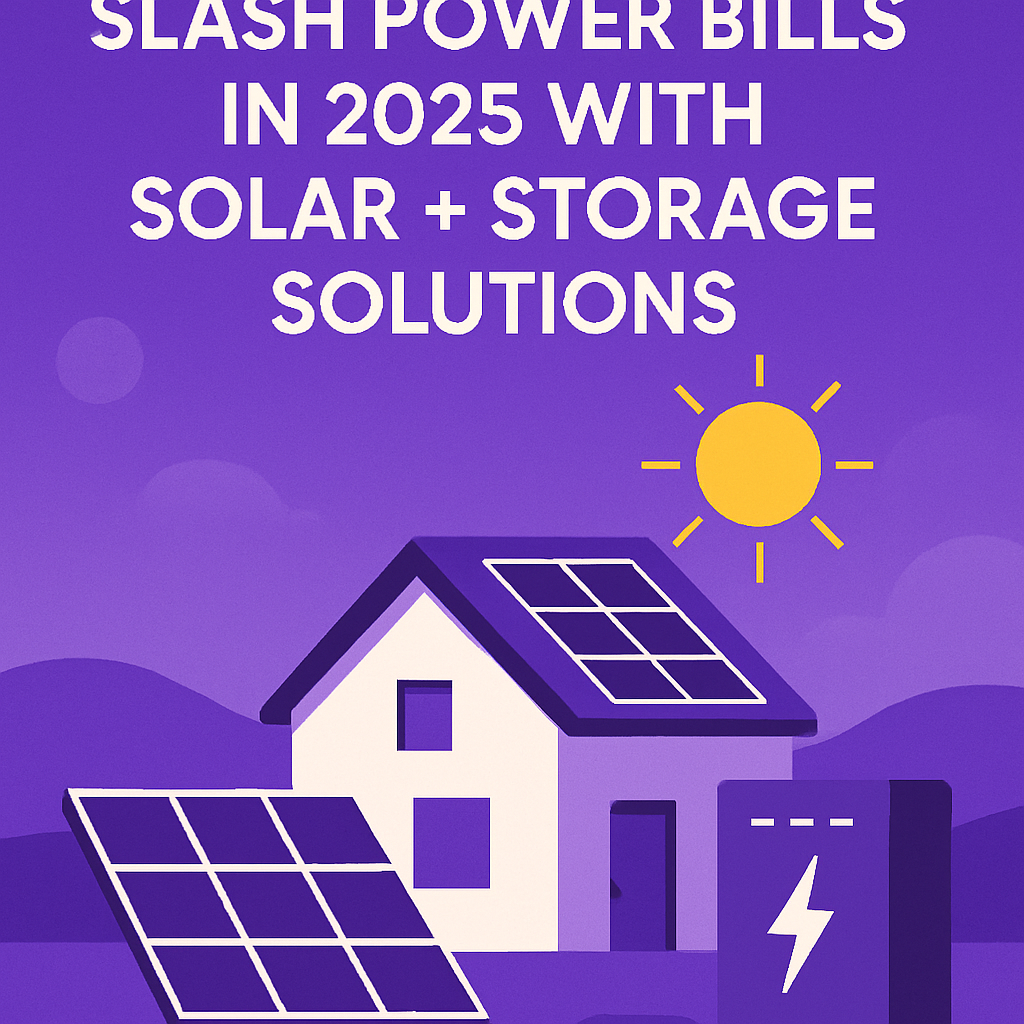Slash Power Bills in 2025 with Solar + Storage Solutions
As electricity costs continue to rise in Australia, more homeowners and businesses are turning to solar power combined with battery storage to slash their power bills. This shift not only provides significant financial savings but also contributes to a sustainable energy future. In this article, we explore the components of a solar + storage system, analyze case studies, and compare top brands and technologies, providing comprehensive insights into maximizing savings and enhancing energy independence.
Understanding Solar + Storage Solutions
Solar + storage systems integrate solar panels with battery storage to harness and store energy from the sun. This setup allows you to use solar power even when the sun isn’t shining, significantly reducing reliance on the grid.
Solar Systems and Battery Storage
A typical solar system comprises solar panels, an inverter, and a battery storage unit. Solar panels capture sunlight and convert it into electricity, which is then transformed by the inverter into usable power for your home or business. Excess energy can be stored in a battery for later use, ensuring a consistent power supply.
The importance of Small-scale Technology Certificates (STCs) and Large-scale Generation Certificates (LGCs) cannot be overstated. These certificates are part of Australia’s Renewable Energy Target (RET), designed to incentivize renewable energy adoption. STCs apply to small-scale installations, while LGCs are relevant for large-scale projects.
Regional differences impact the efficiency and savings potential of solar systems. For example, areas with high solar irradiance, like Sydney, typically see greater energy production and financial returns.
Case Study: 6.6kW System in Sydney
A 6.6kW solar system in Sydney can generate approximately 24-28 kWh of electricity per day, depending on weather conditions and installation factors. With average electricity costs around 30c per kWh, this system can save homeowners up to $3,000 annually. The return on investment (ROI) for such systems is typically achieved in 4-6 years, making it a financially sound decision for many.
Brand Comparison: Solar Panels
Choosing the right solar panels is crucial for maximizing efficiency and longevity. Here’s a comparison of top brands:
- Aiko Solar: Known for high-efficiency panels and competitive pricing. Warranty: 12 years product, 25 years performance.
- Longi Solar: Offers cost-effective solutions with a strong focus on monocrystalline technology. Warranty: 12 years product, 25 years performance.
- REC Group: Premium panels with excellent efficiency and robust warranties. Warranty: 25 years product, 25 years performance.
- Trina Solar: Reliable performance and affordability. Warranty: 10 years product, 25 years performance.
Each brand offers unique benefits, and selecting the ideal option depends on individual needs and budget considerations.
Financial Incentives and Rebates
Australia provides numerous financial incentives and rebates to encourage solar adoption. These include federal and state-specific initiatives, such as Feed-in Tariffs (FiTs) and rebate schemes that reduce installation costs.
Example: Vic vs NSW FiTs
Victoria and New South Wales have distinct FiT structures, impacting financial benefits:
- Victoria: Offers a minimum FiT of 6.7c per kWh, with additional state rebates up to $1,400 for eligible systems.
- New South Wales: FiTs vary by provider, averaging between 6 and 12c per kWh. The state also provides interest-free loans for battery storage.
Understanding these differences is crucial for optimizing financial returns and selecting the best installation location.
Inverters and Battery Technology
Reliable inverters and advanced battery technology are vital for efficient energy conversion and storage. Inverters transform DC electricity from solar panels into AC power for home use, while batteries store excess energy for later consumption.
Brand Comparison: Inverters & Batteries
Comparing leading brands helps identify the best solutions:
- Fronius: Known for robust inverters with excellent monitoring capabilities. Warranty: 5 years standard, extendable to 10 years.
- SolarEdge: Offers innovative solutions with power optimizers for enhanced performance. Warranty: 12 years standard, extendable to 25 years.
- Tesla Powerwall: A popular battery choice with high storage capacity and seamless integration. Warranty: 10 years.
- BYD: Provides flexible and scalable battery systems. Warranty: 10 years.
Selecting the right combination of inverters and batteries ensures optimal system performance and longevity.
Real-World Payback Periods
Understanding payback periods is essential for evaluating the financial viability of solar + storage systems. These periods vary based on system size and location but typically range from 4 to 8 years.
ROI Calculator Example
To assist potential adopters, we offer a free AI-powered bill analysis tool. By inputting specific details, users can estimate savings, payback periods, and ROI, making informed decisions about solar investments.
FAQ: Common Questions About Solar and Battery Installations
- What is the lifespan of a solar system? Most systems last 25-30 years with proper maintenance.
- How does battery storage work? Batteries store excess solar energy for later use, reducing grid dependency.
- Are there maintenance requirements? Regular inspections and cleaning ensure optimal performance. Our HVAC Maintenance & Repairs service can help maintain system efficiency.
- What happens during cloudy days? Systems still generate energy, albeit less. Batteries and grid connections supplement power needs.
- Is solar installation feasible in apartments? Yes, especially with Commercial & Strata Charging solutions tailored for multi-unit dwellings.
Conclusion
Solar + storage systems represent a powerful solution to combat rising electricity costs in Australia. By harnessing renewable energy, homeowners and businesses can enjoy significant savings, energy independence, and environmental benefits.
At Hilts, we offer a range of expert services, from ASP Level 2 Works to General Electrical Services. We invite you to explore our offerings and take advantage of a free AI-powered bill analysis or site assessment to optimize your energy strategy. Let us help you transition to a more sustainable and cost-effective energy future.


